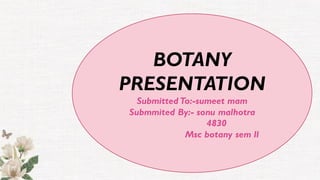
family liliaceae
- 1. BOTANY PRESENTATION Submitted To:-sumeet mam Submmited By:- sonu malhotra 4830 Msc botany sem ll
- 2. Taxonomy and Systematic Botany Family: Liliaceae (Lily Family)
- 4. Family Lilaceae (lily family) • Its Monocot Family and Liliaceae are fairly large family comprising about 250 genera and 4000 species.
- 5. Diagnostic Features 1. Perennial herbs often with bulbous stem / rhizomes. 2. Radical leaves 3. Perianth showy. 4. Stamens six. 5. ovary superior
- 7. General Characters:- Distribution: Liliaceae are fairly large family comprising about 250 genera and 4000 species. Members of this family are widely distributed over most part of the world. Habit: Mostly perennial herbs persisting by means of a rhizome (Polygonatum), by a bulb (Lilium) corm ( Colchicum), shrubby or tree like (Yucca and Dracaena ).Woody climbers, climbing with the help of stipular tendrils in Smilax.Trees in Xanthorrhoea, succulents in Aloe.
- 8. Root:Adventitious and fibrous, swollen due to storage of food . Stem: Stems usually bulbous, aerial, erect (Dracaena) or climbing (Smilax) in Ruscus the ultimate branches are modified into phylloclades, In Asparagus stem is modified into cladodes and the leaves are reduced to scales. Leaf: Leaves are radical ( Lilium) or cauline (Dracaena), usually alternate, opposite (Gloriosa), sometimes fleshy and hollow, reduced to scales (Ruscus and Asparagus).The venation is parallel but in species of Smilax it is reticulate. Leaves are usually exstipulate, but in Smilax , two tendrils arise from the base of the leaf, which are considered modified stipules.
- 10. Inflorescence: Variable-solitary (Tulipa, Fritillaria), panicled raceme (Asphodelus), cymose umbel (Allium, Smilax), solitary axillary (Gloriosa).
- 11. Flower: Pedicellate, actinomorphic or zygomorphic (Lilium, Hemerocallis), hermaphrodite or unisexual in Smilax, Ruscus; hypogynous, complete or incomplete (in unisexual flowers), trimerous rarely 2 or 4-merous ,Bracteate Perianth: Six,two in whorls of three each,poly or gamophyllous, odd tepal of outer whorl anterior , inferior.
- 12. Androecium: Stamens 6, arranged in two whorls of three each, epiphyllous , apostamenous /free and opposite to tepals.Anthers dithecous, basifixed, introse, and dehiscing longitudinally. Gynoecium:Tricarpellary and syncarpous. Ovary superior, trilocular with two ovules in each locule on axile placentation. Style simple, slender with simple stigma. Fruit:A loculicidal capsule or berry Seed: Endospermous Floral Formula:
- 14. Primitive characters: 1. Perennial and arboreal habit in some genera (Aloe, Yucca). 2. Leaves simple and spirally arranged in most genera. 3. Solitary flowers in some genera. 4. Flowers hermaphrodite and actinomorphic. 5. Flowers are large and hypogynous. 6. Perianth polyphyllous in some genera (Asphodelus, Veratrum). 7. Seeds endospermic.
- 15. Advanced characters: 1. Many plants are herbaceous. 2. Leaves exstipulate,opposite or whorled in some genera. 3. Flowers are zygomorphic in some genera (Lilium, Hemerocallis). 4. Flowers unisexual (Ruscus,Smilax). 5. Perianth gamophyllous in many genera. 6. Stamens epiphyllous. 7. Reduction in the number of stamens to 3 (Ruscus). 8. Carpels 3 or 2 and syncarpous. 9.Axile placentation.
- 16. Common plants of the family: 1. Allium: Cultivated in winter for bulbs. 2. Aloe: Shrubby xerophytic plant, wild on rocks with dull red flowers. 3. Asphodelus: Common winter weed in wheat fields. 4. Asparagus: A thorny climbing under-shrub with cladodes and fasiculated roots. 5. Colchicum (Meadow saffron): Corm is very useful.It gives Colchicine.
- 17. 6. Dracaena: Tree with anomalous secondary growth in the stem. 7. Fritillaria: Grown in garden as ornamental. 8. Gloriosa (Glory lily): Climber with tips of leaves turned into tendrils. 9. Ruscus: Flowers arise on the upper surface of phylloclades. 10. Smilax: A climber with stipular tendrils and reticulate venation. 11. Tulipa: Grown in garden as ornamentals.
- 19. AsphodelusTenuifolius Habit: An annual weed. Root: Adventitious, fibrous. Stem: Compressed, herbaceous, without nodes and internodes, smooth, greenish brown, aerial, peduncles are erect and fistular. Leaves: Radical, simple, cylindrical, green, pointed, smooth, apex acute, exstiuplate, sessile, sheathing leaf-base, parallel venation.
- 20. Inflorescence: Compound raceme. Flower: Bracteate, pedicellate,incomplete, actinomorphic,hermaphrodite, hypogynous,trimerous,bisexual Colour:-white Perianth: Tepals 6 in two whorls of 3 each, large, petaloid, polyphyllous,sometimes slightly fused at the base,imbricate aestivation, inferior.
- 21. Androecium: Stamens 6, epiphyllous, in two whorls of 3 each, polyandrous, anthers dithecous; dorsifixed or versatile inferior. Gynoecium: Tricarpellary, syncarpous, tilocular, axile placentation, 2 ovules per loculus, ovary superior, style slender, filiform, stigma trilobed, yellow. Fruit: Loculicidal capsule. Floral formula:
- 23. Allium cepa Habit: An annual cultivated herb. Root: Adventitious fibrous. Stem: Underground tunicated bulb,extremely reduced to a conical disc like structure. Leaves: Radical,cylindrical,long, exstipulate,sessile, fleshy,sheathing leaf-base,hollow,multicostate parallel venation.
- 24. Inflorescence: Monochasial cymes enclosed by 2 or 3 membranous bracts arranged in an umbellate fashion on an erect leafless scape. Flower: Pedicellate, small, hermaphrodite, hypogynous,complete,bisexual,actino morphic, trimerous, white, ebracteate. Perianth: Tepals 6, in 2 whorls of 3 each, gamophyllous, united at the base, white, inferior.
- 25. Androecium: Stamens 6, polyandrous, in two whorls of 3 each, epiphyllous, filament narrow, dilated at the base, anthers dithecous, dorsifixed. Gynoecium: Tricarpellary, syncarpous, ovary superior, trilocular, axile placentation, 2 ovules per loculus; style short filiform, stigma minute. Floral formula:
- 27. Economic importance of the family liliaceae • The economic importance of the plants belonging to the Liliaceae family are: • • Source of Medicine –Aloe vera,Smilax and Colchicine. • Ornamental Plants –Lilium, tulips, Gloriosa and Ruscus. • Source of food (or)Vegetables-Asparagus. • Bulbs of Allium cepa and the roots of various species of Smilax are used as flavouring agents.
- 28. Economic Importance of Liliaceae: 1.Food Allium cepa (Onion),Allium sativum (Garlic) and Asparagus are edible and used as food. 2.Medicinal: Smilax,Aloe,Gloriosa,Veratrum,Colchicum,Scilla and Urginea yield useful drugs. Rat poison is obtained from Urginea and the bulbs of Scilla.Aloe vera yields“Aloin”. The roots of Asparagus (H.Satavaer) yields a tonic.From Colchicum,colchicine is obtained. 3.Fibres: Yucca,Phormium tenax yield fibres of commerce. 4.Resin Dracaena and Xanthorrhoea yield resin.From the acrid resin of Xanthorrhoea sealing wax is prepared. 5.Ornamentals The common cultivated garden plants areTulipa, Lilium,Gloriosa,Aloe,Ruscus, Dracaena,Asparagus,Yucca,Hemerocallis etc.